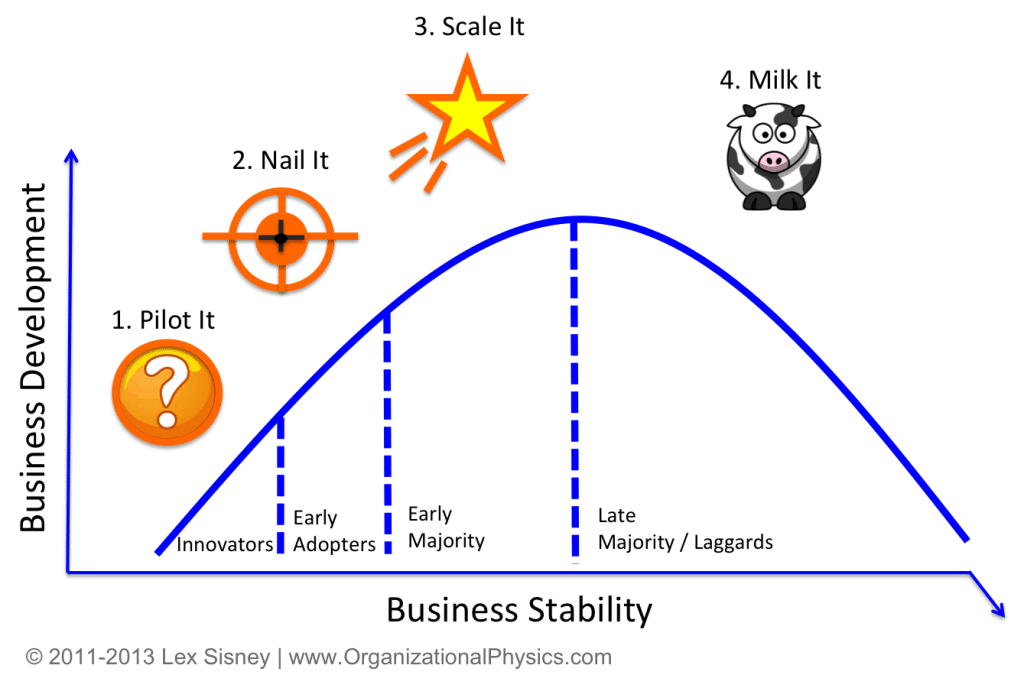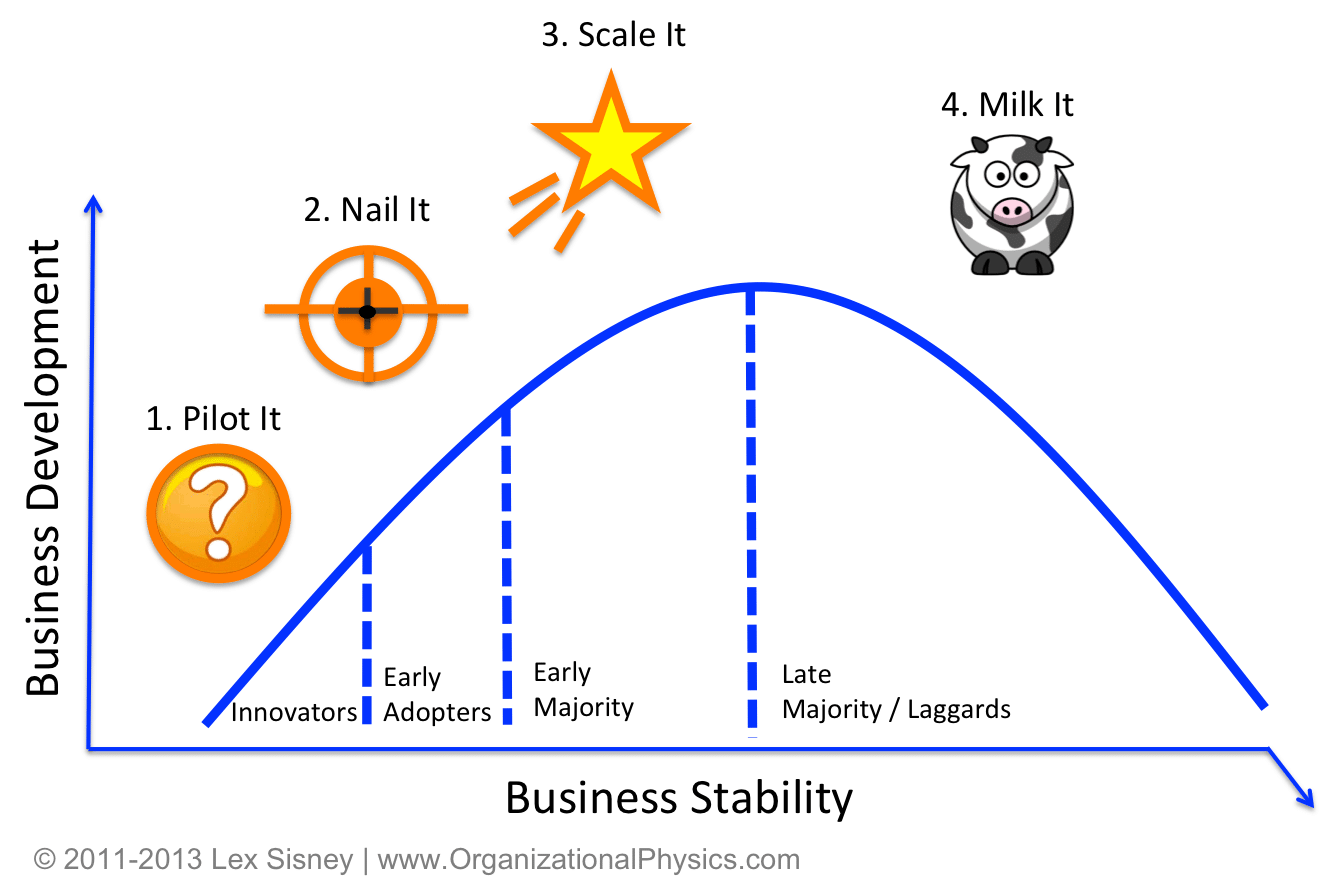Choose the Right Customers at the Right Stage
Summary Insight:
The Lean Startup only works if you’re talking to the right customers at the right stage. Disruption dies when you pitch tomorrow’s product to yesterday’s market.
Key Takeaways:
- Match product stage with customer type—Pilot for Innovators, Nail it for Early Adopters.
- Late Majority clients preserve the status quo—they won’t help you disrupt it.
- Lean and Agile work best when aligned with lifecycle strategy, not just speed.
Entrepreneurial guru Steve Blank (awesome systems thinker) has an article coming out on the cover of Harvard Business Review this month: “Why the Lean Startup Changes Everything.”
I really appreciate the framework of the Lean Startup approach and I’m a big fan of the movement. One thing I notice that’s missing from it is a discussion on the lifecycle stages of the customers that the lean startup should be targeting/getting feedback from. Here’s what I mean:
The Product Lifecycle goes like this: Pilot it, Nail it, Scale it, Milk it, Kill it.
The Market Lifecycle of customer types goes like this: Innovators, Early Adopters, Early Majority, Late Majority/Laggards.
In order to navigate from the temporary organization of a startup, find the business model, and scale it, the disruptive entrepreneur should seek to align this sequence of steps together. I.e., Pilot it for Innovator Customers. Nail it for Early Adopters. Scale it for the Early Majority, and Milk it for the Late Majority/Laggards like this:

Put another way, you DON’T want to be Piloting a project for a Late Majority/Laggard clients or misaligning the other stages. Why not? Because those Late Majority/Laggard clients are old and stable. They are outstanding at telling the entrepreneur what the market needs now (or 5 years ago) but tend to be incapable of identifying where it’s going to be 5 years from now. To find that out, you have to go to the fringe — those Innovator and Early Adopter Clients that aren’t currently served by the status quo. That’s where the true disruption lies.
Late Majority/Laggard clients also have a vested interest in maintaing the status quo. So even if the entrepreneur has a visionary champion within that Late Majority/Laggard client, he or she is going to be blocked by the surrounding inertia within that large, stable organization. The Late Majority/Laggard client is also subjected to broad market forces and quarterly financial targets that may require it to shift directions. So even promises of “yes, build this for us at this price and we’ll roll it out to our distribution network” aren’t worth the email they were written on when market forces change.
A great example of this principle in action is Square, a great disruptive force in the mobile payments space. Notice that Square DID NOT go to Visa, Mastercard, and Paypal to find the initial product market fit. They went to taco truck vendors, independent artists, and others SOHO’s who were NOT served by the status quo. If CEO Jack Dorsey did go to Visa or Pay Pal to practice the Lean Startup methodology and find the product market fit, he would have gotten great product specs to support the current payments model — but not to disrupt it. I’ve written about this in detail here.
The Real Purpose of the Lean Startup Methodology
Those of you who have read my Part III of my book Organizational Physics — The Science of Growing a Business already know that what the Lean Startup or customer-driven development approaches are really trying to do is to help the entrepreneur and the start-up business unit go as far as possible from the start of quadrant 1 (Pilot it for Innovators) to the top of quadrant 2 (Nail it for Early Adopters) by interviewing, researching, and selling customers in advance before the product development process begins.

In other words, customer-driven development tries to limit the cost, risk, and time investment of making poor product or market decisions between the Pilot It and Nail It stages. They are looking for a good product/market fit before the development process begins. If they can discover what the thought leaders really value and what the early adopters’ true spending priorities are before development begins, this lowers the risk and increases the probability of meeting those needs. Development can become more focused and demand is established before any real money is spent on development.
Agile software development is a product development method that aligns very closely with a customer-driven philosophy. Agile, or iterative, development is a process of taking real-time data from actual use of the product and quickly iterating changes using short release cycles to develop a better product that meets the needs of target customers. Fundamentally, agile is a product development method that attempts to better manage changing requirements; avoid long release cycles; and produce live, working, tested software that has real business value. In an early-stage startup, using an agile approach can help a company quickly and cost-effectively navigate the Pilot It to Nail It stages by eliminating the guesswork, long product release cycles, and overhead involved in trying to do a big product design up front. In larger companies with existing products in scale mode, using agile is an attempt to better meet user requirements, based on data and customer feedback, and to turn that knowledge more quickly into new product features and extensions.
Having built several successful high-tech products and run agile development teams, I can say that I am a big fan and believer in both approaches. They go hand in hand. Their real but unstated goal is to help a company navigate up the path to prosperity more quickly and cost-effectively. These approaches can help verify that your thinking is sound, that demand is there and you’ve uncovered a proven market opportunity. Additionally, having evidence that your entrepreneurial vision is baked in the cold, hard light of reality can make all the difference in raising the capital you need. These are sound methods and they fit perfectly well into the strategy lifecycle scheme.
The truth is that there are many other methods that can also help you quickly navigate the path to prosperity. Customer-driven can work. So can vision-driven. For example, I don’t believe Steve Jobs had ever done a day of interviewing customers in his entire life. Instead, he had that rare ability to envision something entirely new, intuitively understand the needs of his target customers even before they did, and bring his vision to the world in surprising and beautiful ways. No external customer-driven development of the iPad would have worked because customers would have had no frame of reference for it. Walt Disney was the same way. He had a powerful vision and followed his own instincts about what families really valued that wasn’t being provided by other amusement parks at the time. He created magical experiences that no one was expecting. The point is that there are many ways to develop a product but the fundamentals of strategy should always the same: You must go the long way around the path and create the product/market fit in the right sequence.
I hope this helps with your thinking as you contemplate how the Lean Startup meme will play out in your own organization.




